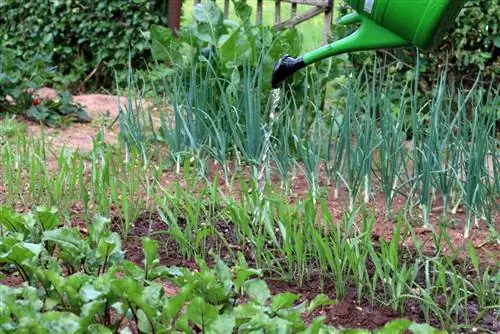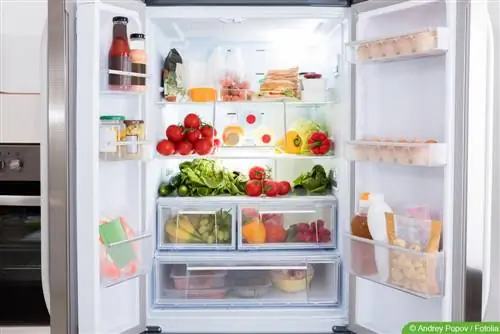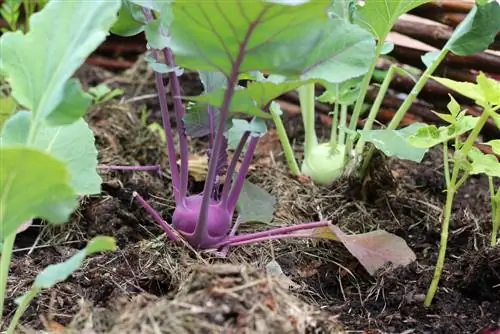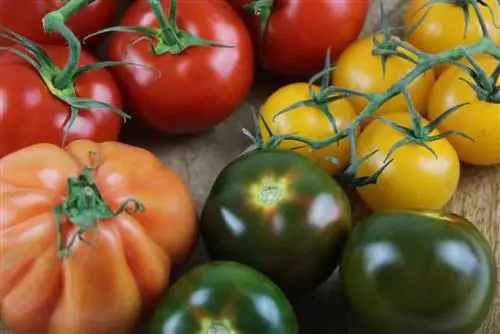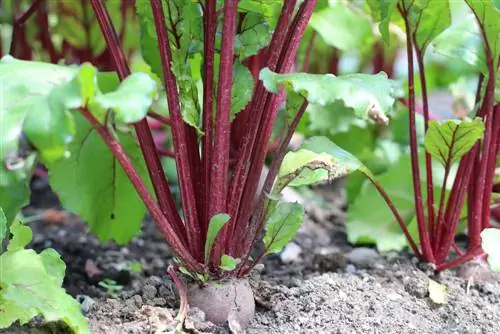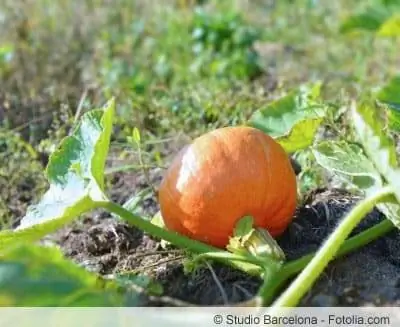- Author admin [email protected].
- Public 2023-12-17 03:39.
- Last modified 2025-06-01 06:48.
If vegetables are grown together in the garden, there is a lot to consider. In the optimal case, the plants complement each other and are well adapted to the specific conditions of the location. We find this phenomenon everywhere in nature. Such plants also make good neighbors in the garden. Such a harmonious and diverse plant community is also strived for in mixed cultivation in your own garden. However, this is not always that easy given the large number of vegetables.
Mixed Culture
Some plants get along, others don't. It's the same with vegetables. A mixed culture refers to plant communities that can also occur in different locations in nature. In the vegetable garden, different types of vegetables are usually planted in rows next to each other. Whether joint cultivation is beneficial or not is largely determined by the nutrient requirements of the individual plant. A distinction is made according to:
- Heavy eaters such as cabbage, celery and tomatoes
- Medium-strength foods such as carrots, lettuce or onions
- Weak foods such as beetroot and herbs
Tip:
The root depth should also be different so that the vegetable plants don't get in each other's way.
Advantages of mixed culture
The plants also release active ingredients into the soil or air. Some of these active ingredients can be compared to antibiotics, which have a promoting or inhibiting effect on their neighbors. With favorable combinations, pathogens or pests such as whiteflies can be kept away in this way. Through mixed culture, the individual plants grow better and he althier. In this case, additional fertilization and the use of pesticides are often unnecessary. Other combinations can also have taste-enhancing effects.
- requires less space
- less mulching and fertilizing necessary
- less watering required due to dense growth
- Shading neighboring plants
- keeps pests and pathogens away
- does not leach the soil on one side
- important cultural partners are also herbs
- Nitrogen fertilization possible through suitable vegetable plants
- long and short ripening times can be used
Important Rules
There are a few important rules to follow when it comes to mixed culture. In addition to the optimal distance between the individual plants, the following applies:
- The direct neighbors are not allowed to dispute each other's space or disturb each other. This rule applies to both the parts of the plant growing underground (tubers and roots) and the parts above ground. Ideally, you plant deep-rooted plants next to shallow-rooted plants (like carrots next to lettuce). Heavy feeders like cabbage grow well next to weak feeders like peas. And sun lovers like corn form a good partner to plants like pumpkin, which prefers it a little shady.
- Fragrances and root exudates from one plant should benefit the neighboring plant. Some plant exudates inhibit the growth of other vegetable plants or are even fatal. This should be taken into account not only in the shared culture, but also in the crop rotation.
- Plants that attract the same pests as cruciferous vegetables must not be cultivated together. Otherwise the entire harvest may fail.
Generally the rule applies:
Cruciferous vegetables, legumes and umbelliferous plants are not compatible with each other.
Ex.: Cabbage should not be grown with cabbage.. Combinations with legumes or umbelliferous plants are well suited for this.
- Cruciferous vegetables: Cauliflower, broccoli, Chinese cabbage, kale, kohlrabi, radishes, radishes, Brussels sprouts, red cabbage, rocket, white cabbage
- Umbelliferous: Dill, fennel, carrots, chervil, caraway, lovage, parsnips, parsley, celery
- Pulses: Beans, lentils and peas
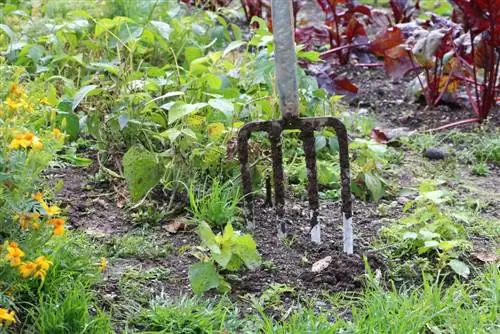
List of good neighbors
The plant combinations in mixed culture are based on decades of experience in organic gardening.
A to M
Beans
When it comes to beans, a distinction is mainly made between climbing runner beans and low-growing bush beans. For example, climbing bean varieties benefit from corn, which can serve as a climbing aid. On the other hand, heavy-consuming vegetables enjoy the nitrogen that beans produce in the soil. The fragrance of the savory promotes the growth and taste of the beans and also keeps the black bean louse away.
pole beans
Good neighbors
- Savory
- Endive
- Cucumber
- Cabbage (Brassica species)
- Lettuce
- Corn
- Radish and radish
- Celery
- Spinach
- Zucchini
Bush beans
Good neighbors
- Savory
- Strawberry
- Cucumber
- Cabbage (Brassica species)
- Head and picking lettuce
- Beetroot and white beetroot
- Celery
- Tomatoes
Bad neighbors for beans: peas, fennel, garlic, leeks and onions

Endives
Endives are also ideal for growing in mixed cultures.
Good neighbors
- Fennel
- various types of cabbage (Brassica)
- Leek
- pole beans
Peas
Like beans, peas are among the nitrogen collectors in the soil. They are therefore suitable as partners for a number of heavy eaters.
Good neighbors
- Dill
- Fennel
- Cucumber
- carrot
- Cabbages (Brassica)
- Corn
- Lettuce
- Radish
- Zucchini
Bad neighbors: bean, potato, garlic, leek, tomato, onion
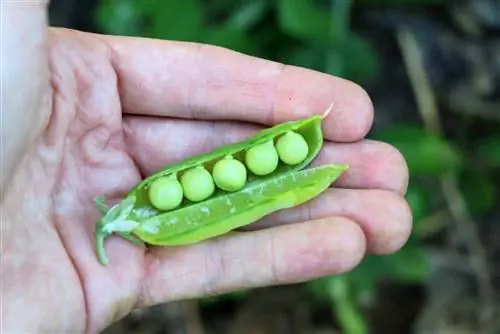
Fennel
Fennel should not be grown together with other umbelliferous plants.
Good neighbors:
- Endive
- Pea
- Lamb lettuce
- Cucumber
- Head and picking lettuce
- Sage
Bad neighbors: bean, carrot, parsnip, parsley, celery and tomato
Cucumbers
A tried and tested combination consists of shallow-rooted cucumbers and deep-rooted celery, which also loves warmth. In addition, cucumbers benefit from being a heavy feeder of vegetables that produce nitrogen in the soil with the help of bacteria. These include legumes such as peas and beans. Basil protects cucumbers against powdery mildew and whitefly. If you plant borage or basil near cucumbers, you will attract insects for pollination.
Good neighbors:
- Types of beans
- Dill
- Pea
- Fennel
- Cabbage (Brassica)
- Lettuce
- Caraway
- Leek
- Corn
- Beetroot and white beetroot
- Onion
Bad neighbors: radishes, tomatoes
Tip:
In the greenhouse, a combination of cucumbers and tomatoes promotes diseases, in the open field both vegetables get along well with each other.
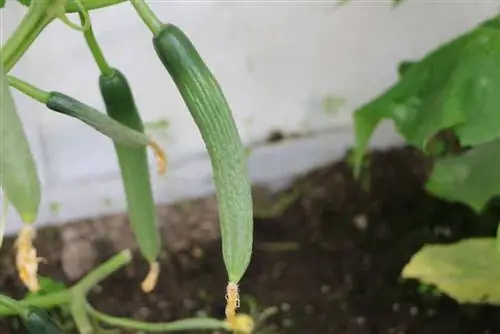
Potatoes
In order to be able to harvest strong, he althy potatoes, the plants can be cultivated together with broad beans, as these prevent infestation with the Colorado potato beetle to a certain extent. Planting caraway or coriander in the bed improves the taste of the popular tuber. At the beginning of the growing season, fast-growing vegetables such as spinach or radishes can also be planted in the gaps.
Good neighbors:
- Cabbages (Brassica)
- Coriander
- Caraway
- Corn
- Radish
- Spinach
- (Tagetes)
Bad neighbors: other nightshades (such as peppers and tomatoes), peas, garlic, cabbage, beetroot and beetroot, celery, onion
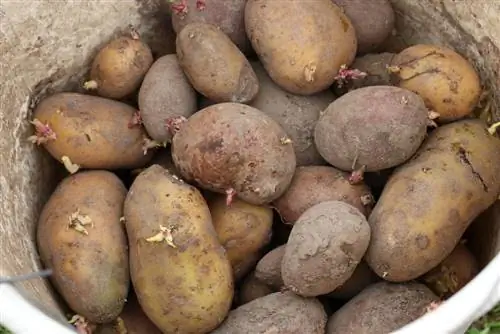
garlic
Perfect neighbors are garlic and strawberries, as garlic prevents gray mold on strawberries.
Good neighbors:
- Strawberry
- Cucumber
- Carrot
- Beetroot and white beetroot
- Tomato
Bad neighbors: pea, cabbage, runner bean
Types of cabbage
The types of cabbage include the classic types of vegetable cabbage (Brassica oleracea) such as cauliflower, green cabbage, palm cabbage, rose cabbage, red cabbage, white cabbage, pointed cabbage, broccoli, Romanesco and savoy cabbage. There are also the brassica vegetables from the Brassica rapa family, which include, for example, Chinese cabbage and bok choy. They are susceptible to whitefly and clubroot. Therefore they should not be planted with garlic and onions.
Good neighbors:
- Types of beans
- Dill
- Endive
- Pea
- Potato
- Lettuce
- Leek
- Celery
- Spinach
Bad neighbors: other types of cabbage, strawberries, garlic, onions
Kohlrabi
Kohlrabi is a cruciferous vegetable and should therefore not be grown together with other types of cabbage (Brassica).
Good neighbors
- Bean
- Pea
- Potato
- Lettuce
- Leek
- Radish
- Beetroot and white beetroot
- Celery/celeriac
- Spinach
- Tomato
Bad neighbors: all types of Brassica oleracea and Brassica rapa
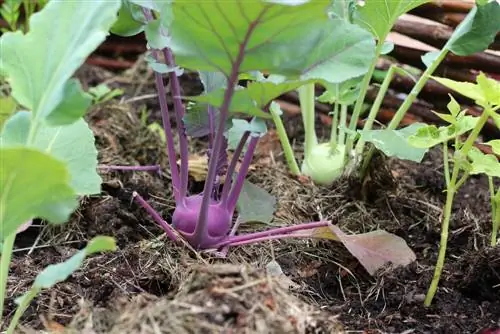
Pumpkin
Pumpkin is a heavy feeder, but is otherwise very easy to care for. Pumpkin was already grown together with beans and corn in the Indian culture. The mixed culture has several positive effects. While the beans fertilize the pumpkin through their ability to form nitrogen in the soil, the leaves of the flat-growing pumpkin plants protect the soil from drying out.
Good neighbors
- Bean
- Broccoli
- Dill
- Corn
Bad neighbors: dill, cucumbers, cabbage
Chard
Chard is compatible with almost all other vegetable plants.
Good neighbors
- bush bean
- Types of cabbage
- Carrot
- Radish
- Radish
- Salad
Bad neighbors: beetroot
Carrots
Carrots can be combined with a variety of other vegetables for a good harvest. Herbs like rosemary keep whiteflies away. Many hobby gardeners are familiar with a mixed culture of carrots and onions because they protect each other from pests. Nevertheless, planting in a bed is controversial because the two types of vegetables have different watering requirements in late summer and autumn. For this reason, leeks go better with carrots because they have similar water requirements.
Good neighbors
- Dill
- Pea
- garlic
- Radish
- Radish
- Rosemary
- Chives
- Tomato
Bad neighbors: parsnip, parsley, celery
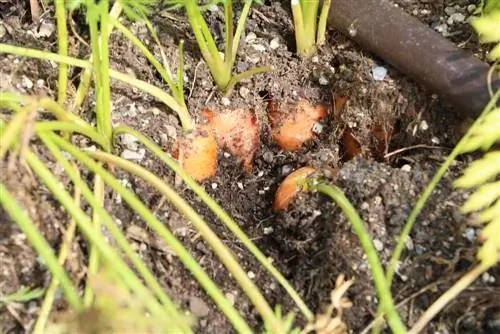
P to Z
Leek
In addition to onion tripe and leek moth, leek is often affected by fungal diseases (leek rust). This is especially the case if the leek is grown with the wrong plants. Good plant neighbors such as radish or wormwood can protect the leek from infestation.
Good neighbors
- Strawberry
- Cabbage (Brassica species)
- carrot
- Lettuce
- Radish
- Celery
- Tomato
- Wormwood
Bad neighbors: beans, peas, garlic, beetroot, chives
Peppers
In order to develop optimally, peppers need a lot of heat. That's why it's good in the greenhouse next to tomatoes. Since pepper plants grow rather stocky, the two plants do not dispute space.
Good neighbors
- carrot
- cabbage
- Tomatoes
Bad neighbors: pea, cucumber, potato, celery
Radish
Radishes are weak eaters and do not develop particularly large roots or foliage. That's why they go well with a variety of other vegetables, with which they can be grown together in a mixed culture. Lettuce between the rows protects radishes from flea beetles.
Good neighbors
- Bean
- Pea
- cabbage
- Lettuce
- Carrot
Bad neighbors: broccoli, cucumber, cabbage, radish, arugula, zucchini
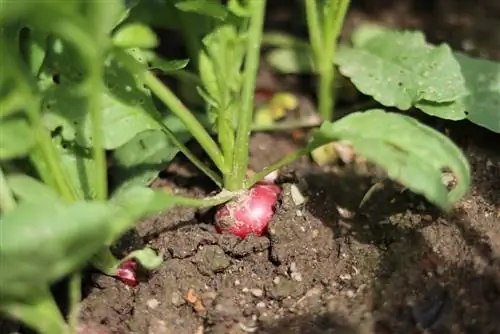
Radish
As with radishes, we recommend planting them in rows with lettuce, as this drives pests such as flea beetles away from the root vegetables.
Good neighbors
- Bean
- Pea
- cabbage
- Lettuce
- Carrot
- Salad
Bad Neighbors: Cucumber
Salads
Crispy salads are an absolute must in the summer garden. When growing, the gardener can choose between many different varieties. It's worth putting chervil between the rows as it keeps lice away from the salads.
Lamb lettuce
Good neighbors
- Endive
- Strawberry
- Kohlrabi
- Radish
- Winter purslane
- Onion
Bad neighbors: Valerian
Lettuce
Good neighbors
- Beans
- Dill
- Pea
- Strawberry
- Cucumber
- carrot
- cabbage
- Leek
- Tomato
- Onion
Bad Neighbors: Celery
Plucking lettuce
Good neighbors
- Broccoli
- Dill
- Pea
- carrot
- Kohlrabi
- Types of cabbage
- Corn
- Chard
- Parsnip
- Radish
- Brussels sprouts
Bad neighbors: zucchini
Tip:
Parsley has proven to be a bad neighbor for all types of salads. Salads do not tolerate the aggressive essential oils of parsley.
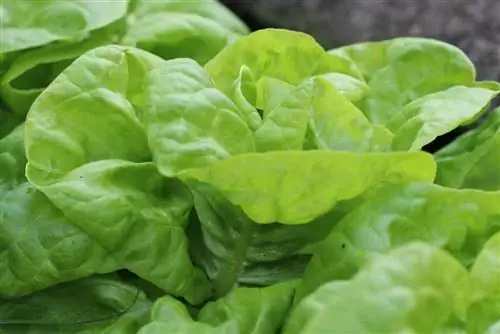
Celery
Celery goes well with the various types of cabbage. To make the potassium from the soil more available to the celery, buckwheat can be sown between the rows. A common culture with cabbage protects, on the one hand, the celery from infestation with celery rust and, on the other hand, the cabbage from the caterpillars of the cabbage white butterfly.
Good neighbors
- bush bean
- Cucumber
- cabbage
- Kohlrabi
- Leek
- Spinach
Bad neighbors: potato, lettuce, corn
Spinach
Good neighbors
- Strawberry
- Potato
- Types of cabbage
- Kohlrabi
- Radish
- Radish
- Runner bean
- Tomato
Bad neighbors: chard, beetroot and beetroot
Tomatoes
Tomatoes require a lot of nutrients and therefore get along well with vegetables that require less, such as bush beans. Garden cress and nasturtiums keep aphids away from tomato plants. A combination with basil protects against mildew and whitefly infestation.
Good neighbors
- Basil
- bush bean
- Garden cress
- Nasturtium
- garlic
- Cabbage (Brassica)
- parsley
Bad neighbors: potato, pea, fennel, cucumber
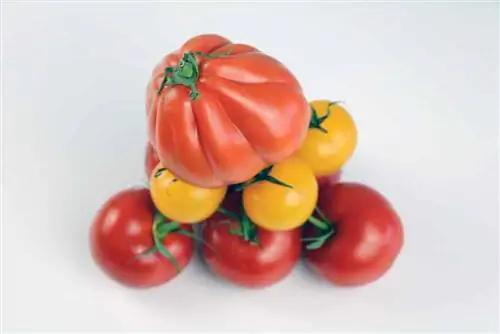
Zucchini
As a rule, growing zucchini in your own garden is quite uncomplicated and promises a good harvest if there are sufficient amounts of nutrients. Zucchini plants primarily need nitrogen. Instead of fertilizing again and again, so-called nitrogen-producing legumes can also be used specifically. This is the name given to plants that can store nitrogen in the soil with the help of bacteria. Among the vegetable plants, peas and runner beans, for example, are nitrogen producers.
Good neighbors
- Pea
- carrot
- Lettuce
- Leek
- Radish
- Beetroot and white beetroot
- Celery
- Spinach
- Runner bean
- Onion
Onions
Good neighbors
- Savory
- Strawberry
- Dill
- carrot
- Lettuce
- Beetroot and white beetroot
Bad Neighbors: Bean, Pea and Cabbage
Rule of thumb for mixed culture
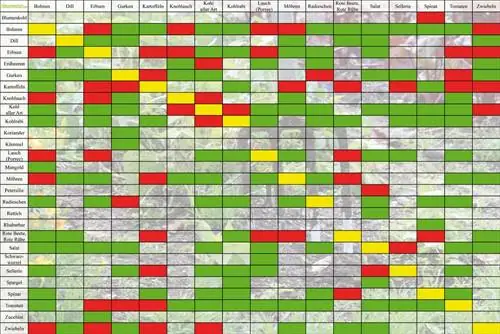
A sensible mixed culture must be well planned. Ultimately, it's about taking advantage of good neighborhoods and avoiding unfavorable ones. An old gardening rule is: Vegetables that produce their fruits underground go well with plants whose fruits ripen above ground. In this way, the plants do not compete for space for roots and leaves and can even be planted closer together. At the same time, the crop yield is increased.
Herbs as partners
Many herbs such as rosemary, mint and sage use their scent to keep pests away from vegetable plants. Others - such as nasturtiums - magically attract pests such as aphids. This means the crops are spared from infestation. Tagetes are effective against root nematodes in potatoes and tomatoes. Other herbs can do even more: They help neighboring plants have a more intense taste. For example, potatoes taste better when they grow next to dill, caraway or coriander. Tomatoes and pumpkins benefit from borage in terms of taste.
Conclusion
Every gardener who wants he althy growth and good yields in their own vegetable garden should know which vegetables can be planted next to each other. The gardener has complete freedom when it comes to the method of cultivation. This means that mixed culture is possible in alternating rows or in a colorful mix. If a space in the bed becomes available, it can be reallocated immediately. In order to keep an overview, you should definitely make a cultivation plan in advance, otherwise you are guaranteed to forget what was in which place.

